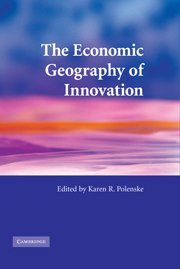Book contents
- Frontmatter
- Contents
- List of figures
- List of tables
- Notes on contributors
- Acknowledgments
- Abstracts
- List of abbreviations and acronyms
- Part I Concepts and measurements in innovation
- Part II Institutional and spatial aspects of information and knowledge flows
- 5 Tacit knowledge in production systems: how important is geography?
- 6 The self-aware firm: information needs, acquisition strategies, and utilization prospects
- 7 Theorizing the gendered institutional bases of innovative regional economies
- 8 Multinationals and transnational social space for learning: knowledge creation and transfer through global R&D networks
- 9 Brain circulation and regional innovation: the Silicon Valley–Hsinchu–Shanghai triangle
- Part III Institutions and innovation systems
- Index
- References
7 - Theorizing the gendered institutional bases of innovative regional economies
Published online by Cambridge University Press: 22 September 2009
- Frontmatter
- Contents
- List of figures
- List of tables
- Notes on contributors
- Acknowledgments
- Abstracts
- List of abbreviations and acronyms
- Part I Concepts and measurements in innovation
- Part II Institutional and spatial aspects of information and knowledge flows
- 5 Tacit knowledge in production systems: how important is geography?
- 6 The self-aware firm: information needs, acquisition strategies, and utilization prospects
- 7 Theorizing the gendered institutional bases of innovative regional economies
- 8 Multinationals and transnational social space for learning: knowledge creation and transfer through global R&D networks
- 9 Brain circulation and regional innovation: the Silicon Valley–Hsinchu–Shanghai triangle
- Part III Institutions and innovation systems
- Index
- References
Summary
Introduction
During the past two decades, scholars and policymakers have debated how best to promote and harness innovation in regional economies. Much of the resulting regional literature focuses on creating conditions conducive to knowledge creation, information dissemination, entrepreneurship, and learning. However, although this literature extensively documents the formal interactions that underpin innovative regional economies, it is less satisfying in its treatment of the informal socioinstitutional bases. Critically, we still do not fully understand how distinctive patterns of social relations reinforce more formal interactions within these regions, and hence how they contribute to economic performance. Although many analysts typically suggest something intangible that permits innovation to proceed in some places but not in others, they often fail to specify the exact nature of the processes through which key sociorelational structures promote innovative activity more successfully in some regions than in others.
One major component of this problem is a dominant tendency within the regional learning and innovation literature to treat elite workers as an homogeneous group with little differentiation across gender, race, or cultural background. Although scholars argue that collective learning and innovation processes are enhanced by a shared social environment that supports interaction (e.g. Lorenz 1992; Keeble and Wilkinson 1999), this shared social environment is too often conceptualized as implicitly masculine, and hence distinctive patterns of female work and social interaction are sidelined.
- Type
- Chapter
- Information
- The Economic Geography of Innovation , pp. 129 - 156Publisher: Cambridge University PressPrint publication year: 2007



